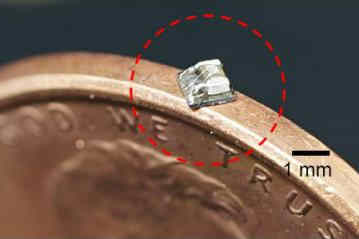Tiny implant changes brain patterns
Researchers in Japan have developed what they say is the world’s smallest and lightest wireless optical neural stimulator. Optogenetics uses light to change neural behaviour by activating certain proteins in the brain to change brain patterns. The new 1mm3, 2.3mg device is orders of magnitude smaller than other such biodevices currently being tested.
The miniaturization of implantable devices has been hindered by a dependency on electromagnetics. In such devices, both the voltage and the current decrease with a reduction in size, thus limiting the power. On the other hand, in devices that depend on photovoltaics, voltage remains unchanged as size is reduced.
The new device can be activated with infrared light. Infrared is used in many light therapies, because it can penetrate deep in the body, whereas blue light cannot go much deeper than the surface. Therefore, the device can be implanted several centimeters into the body.
The implant uses a complementary metal-oxide semiconductor that controls photovoltaic power. Researchers say further development is still needed.


























